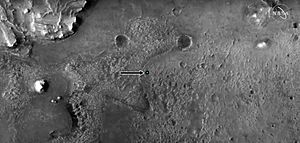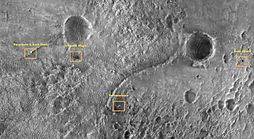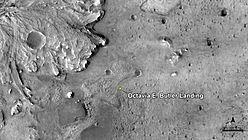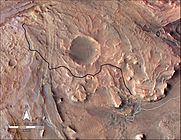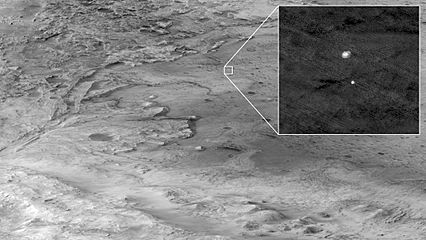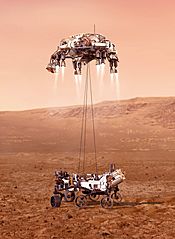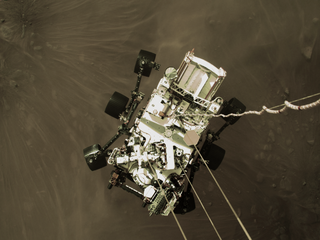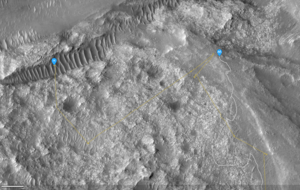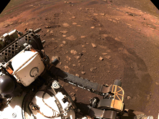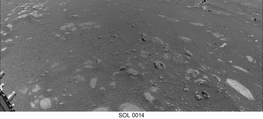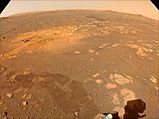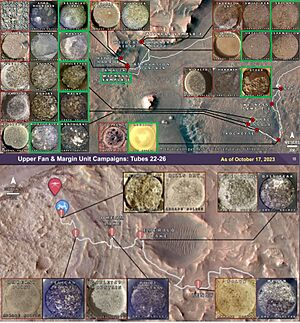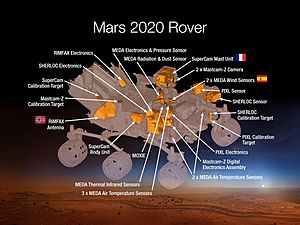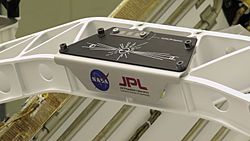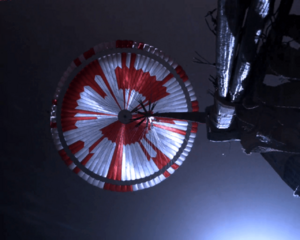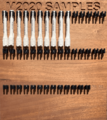Perseverance (rover) facts for kids
Quick facts for kids Perseverance |
|
|---|---|
| Part of Mars 2020 | |
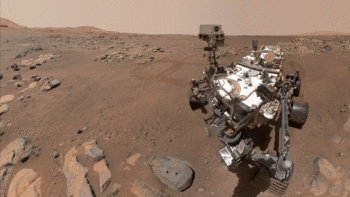
Self-portrait by Perseverance in September 2021 at Rochette, a rock and the site of the first core samples of the Mars 2020 mission.
|
|
| Type | Mars rover |
| Manufacturer | Jet Propulsion Laboratory |
| Technical details | |
| Dimensions | 2.9 m × 2.7 m × 2.2 m (9 ft 6 in × 8 ft 10 in × 7 ft 3 in) |
| Dry mass | 1,025 kilograms (2,260 lb) |
| Power | MMRTG; 110 watt |
| Instruments | |
|
|
Perseverance, also called Percy, is a car-sized robot exploring Mars. It is part of NASA's Mars 2020 mission. The rover was built by the Jet Propulsion Laboratory. It launched on July 30, 2020. Perseverance landed safely in Jezero Crater on Mars on February 18, 2021.
Since landing, Perseverance has been active for many sols (Martian days). NASA named its landing spot Octavia E. Butler Landing. The rover looks a lot like its older sibling, Curiosity, but it has some cool upgrades. It carries seven main science tools, 19 cameras, and two microphones.
Perseverance also brought a small helicopter named Ingenuity to Mars. Ingenuity made history on April 19, 2021. It was the first aircraft to fly on another planet! As of December 2, 2023, Ingenuity has flown 67 times. It keeps breaking its own records for speed and height.
The main goals for Perseverance are to:
- Find old places on Mars that might have supported life.
- Look for signs of tiny past life (microbes) in those places.
- Collect rock and soil samples to bring back to Earth later.
- Test how to make oxygen from the Martian air. This will help prepare for future human missions.
Contents
The Perseverance Mission
In the early 2010s, NASA's Mars exploration plans were uncertain. Budget cuts meant NASA had to change its plans for Mars missions. However, after the success of the Curiosity rover in 2012, NASA decided to launch a new Mars rover by 2020.
Scientists recommended that NASA should start a project to bring Mars samples back to Earth. This project would involve several missions. The first step was to build a rover that could collect and store samples. NASA agreed, and this led to the creation of Perseverance.
Science Goals
The Perseverance rover has four main science goals:
- Find habitable places: Look for past environments that could have supported tiny life forms.
- Seek signs of life: Search for evidence of past microbial life, especially in rocks that preserve these signs.
- Collect samples: Gather rock and soil samples and store them on the Martian surface.
- Prepare for humans: Test how to create oxygen from the Martian atmosphere for future human explorers.
Rover Design and Features
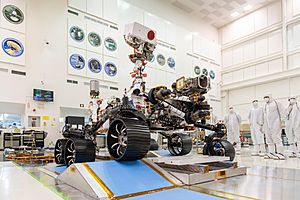
Perseverance is an improved version of the Curiosity rover. They share many parts, like the body, landing system, and power. But Perseverance has stronger, more durable wheels. Its wheels are made of thick aluminum with cleats for grip. They are also slightly larger than Curiosity's.
The rover has a robotic arm that is 2.1 meters (about 7 feet) long. This arm is stronger and helps collect rock samples. It stores these samples in special clean tubes. Because of its new tools and sample system, Perseverance is heavier than Curiosity.
The rover gets its power from a special generator called an MMRTG. This generator uses plutonium-238 to create heat, which is turned into electricity. It provides about 110 watts of power. The MMRTG charges two rechargeable batteries. This power system allows the rover to work even at night or during dust storms.
The rover's computer is very tough. It is designed to handle radiation in space. It has 128 megabytes of memory and runs at 133 MHz. It can also store 4 gigabytes of data.
The Ingenuity Helicopter
The Perseverance rover carried a small helicopter named Ingenuity. This helicopter weighs about 1.8 kilograms (4 pounds). It is a test to see if aircraft can fly on Mars. Ingenuity is solar-powered. It helps scout the area for the rover. It does not carry any science tools, only a camera.
How Perseverance Got Its Name
The name Perseverance was chosen after a contest for K-12 students across the United States. More than 28,000 essays were submitted! A seventh-grade student named Alexander Mather won the contest.
Alexander wrote that past Mars rovers were named after human qualities like Curiosity and Spirit. He felt that Perseverance was the most important quality. He wrote that humans always adapt and explore, even when facing setbacks. This idea of never giving up is what Perseverance means. Alexander and his family were invited to watch the rover launch.
Journey to Mars
The Perseverance rover launched on July 30, 2020. It rode into space on an Atlas V rocket from Cape Canaveral Space Force Station in Florida.
The journey to Mars took about seven months. Perseverance landed in Jezero Crater on February 18, 2021. This is where its science mission began.
Landing on Mars
The successful landing of Perseverance was announced at 8:55 PM UTC on February 18, 2021. The signal from Mars took 11 minutes to reach Earth. The rover landed very close to its target, about 1 kilometer (0.6 miles) southeast of the center of its landing area.
This landing was more accurate than any previous Mars landing. This was possible thanks to lessons learned from Curiosity's landing. It also used new steering technology. One new technology is called Terrain Relative Navigation (TRN). This allows the rover to compare images of the surface during its descent with maps. It can then make last-minute changes to its path. This helps it land safely and closer to its science goals.
The Perseverance landing was even photographed by another spacecraft, the Mars Reconnaissance Orbiter (MRO), from space!
Jezero Crater was chosen as the landing site because it was once a lake basin. Scientists think such places might hold signs of past life.
-
Perseverance parachute descent over Jezero crater photographed by Mars Reconnaissance Orbiter (MRO).
A few days after landing, Perseverance sent back the first audio recorded on Mars. It captured the sound of the Martian wind.
During its travels, a small rock got stuck in one of Perseverance's wheels. NASA scientists saw it and decided it wasn't harmful. The rock stayed with the rover for over 120 days as it traveled more than 5 miles (8 kilometers). NASA joked that Perseverance had adopted a "pet rock" for its journey!
Rover's Journey and Paths
Perseverance plans to explore different parts of Jezero Crater. This includes an ancient river delta, the crater floor, and the crater rim.
The rover made its first test drive on Mars on March 4, 2021. NASA shared photos of the rover's first tracks on the Martian soil.
Samples for Earth Return
Perseverance is collecting rock, soil (called regolith), and atmosphere samples. These samples are stored in special tubes. The goal is to bring these tubes back to Earth in a future mission.
So far, out of 43 sample tubes, 18 have been collected. These include samples of igneous rock, sedimentary rock, soil, and even an atmosphere sample. Some "witness tubes" were also included. These tubes collect any tiny particles from the Martian environment.
Rover Instruments
NASA chose seven main science tools for Perseverance. These tools help the rover study Mars:
- PIXL (Planetary Instrument for X-Ray Lithochemistry): This tool uses X-rays to find out what elements are in Martian rocks and soil.
- RIMFAX (Radar Imager for Mars' subsurface experiment): This radar can see underground. It helps find different layers, buried rocks, and even ice or salty water up to 10 meters deep.
- MEDA (Mars Environmental Dynamics Analyzer): This set of sensors measures the weather on Mars. It checks temperature, wind, pressure, humidity, and radiation.
- MOXIE (Mars Oxygen ISRU Experiment): This amazing tool tries to make a small amount of oxygen from the carbon dioxide in Mars' atmosphere. This is a big step for future human missions!
- SuperCam: This tool can take pictures and analyze the chemicals and minerals in rocks from a distance. It uses lasers to identify signs of past life.
- Mastcam-Z: This is a camera system that can take 3D pictures and zoom in.
- SHERLOC (Scanning Habitable Environments with Raman and Luminescence for Organics and Chemicals): This tool uses a UV laser to find minerals and organic compounds (building blocks of life).
Besides these, Perseverance has many other cameras. It also has two microphones, which are the first ever on a Mars probe. These help engineers during landing, driving, and collecting samples.
Mission Cost
NASA plans to spend about US$2.75 billion on the Perseverance project over 11 years. This includes money for building the rover, launching it, and operating it on Mars.
Perseverance was less expensive than its older sibling, Curiosity. This is because engineers used some spare parts and designs from the Curiosity mission. This saved a lot of money!
Special Plates and Messages
"Send Your Name to Mars"
NASA invited people worldwide to send their names to Mars aboard Perseverance. Over 10 million names were submitted! These names were etched onto three tiny silicon chips. The chips also included essays from the "Name the Rover" contest finalists. These chips are on a special plate on the rover.
Tribute to Healthcare Workers
Perseverance launched during the COVID-19 pandemic. To thank healthcare workers, an 8 x 13 cm (3 x 5 inch) plate was placed on the rover. It shows a staff-and-serpent symbol, which represents medicine. This was a way to honor their hard work during 2020.
Rover Family Portrait
One of the plates on Perseverance shows a simple picture of all NASA's Mars rovers. It includes Sojourner, Spirit, Opportunity, Curiosity, Perseverance, and even the Ingenuity helicopter. It's like a family photo for the Mars robots!
Parachute's Secret Message
The orange-and-white parachute used to land Perseverance had a secret message hidden in its pattern! A NASA engineer used binary code to spell out "dare mighty things." This phrase is the unofficial motto of the Jet Propulsion Laboratory. The parachute also included the GPS coordinates for the Jet Propulsion Laboratory's headquarters in California. Twitter users quickly figured out the code after the image was released!
NASA Outreach to Students
In December 2021, NASA started a program for students who have shown "perseverance" in their school challenges. Students who are nominated can receive a special message sent from Mars by the Perseverance rover itself!
Images for kids
-
Facsimiles of Perseverance's sample tubes at JPL.
See also
 In Spanish: Perseverance para niños
In Spanish: Perseverance para niños



